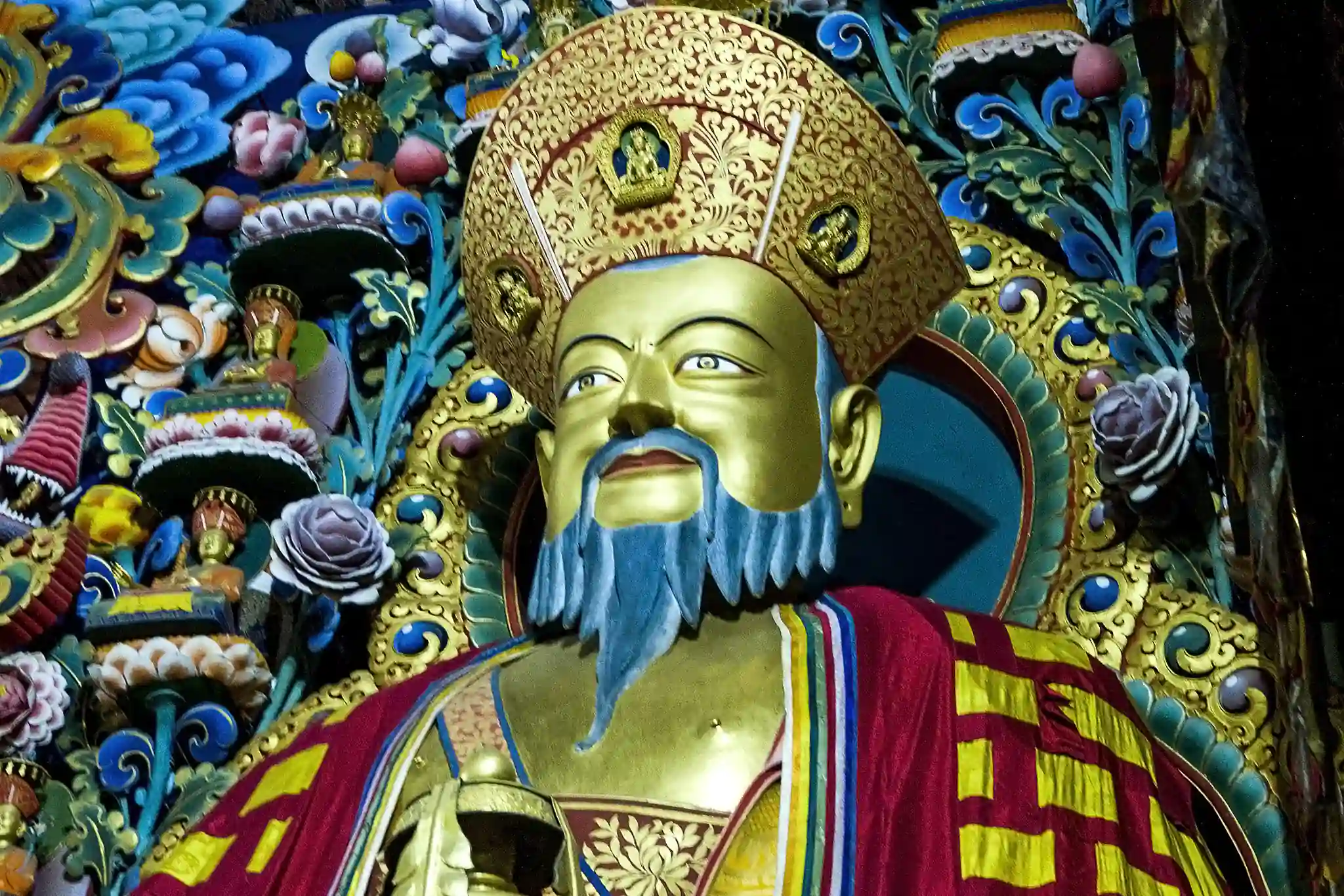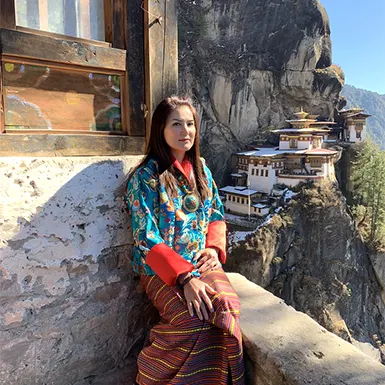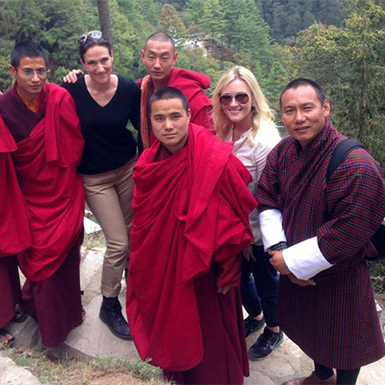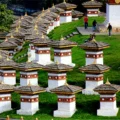In the annals of Bhutanese history, Zhabdrung Ngawang Namgyal stands as a towering figure. Revered as the father of the nation, he was a spiritual leader and visionary statesman who transformed a divided land into a unified country. His influence resonates deeply within Bhutan’s cultural, spiritual, and political fabric.
Arrival of a Spiritual Leader and the Unification of Bhutan
In 1616, Ngawang Namgyal, a respected figure in the Drukpa Kagyu Buddhist tradition, sought refuge in Bhutan, escaping unrest in Tibet. His arrival marked a pivotal moment for a region previously riddled with internal conflict.
Zhabdrung quickly earned the trust and admiration of the Bhutanese people. His teachings, deeply rooted in Buddhist philosophy, resonated with the local communities, offering spiritual guidance and fostering a shared purpose. Recognizing the need for a united nation, he actively sought to consolidate the disparate regions under a single rule.
A Dual System of Governance: The Foundation of a Unified Bhutan
Zhabdrung Ngawang Namgyal established a unique dual system of governance that seamlessly blended spiritual and secular authority. This innovative approach and his unwavering commitment to the Buddhist tradition cultivated a solid national identity and paved the way for Bhutan’s unification.
Early Life and Journey of Zhabdrung Ngawang Namgyal: From Tibet to Bhutan
The Zhabdrung Ngawang Namgyal biography begins with his birth in 1594 at Ralung Monastery in Tibet, marking the start of a life that would shape the destiny of a nation. Recognized as a reincarnation of the 18th abbot of Ralung Monastery and a descendant of the Drukpa Kagyu lineage, his destiny as a spiritual leader was evident from an early age.

Spiritual Upbringing and Recognition
Under the guidance of his father, Mipham Tenpai Nyima, the lineage holder of the Drukpa Kagyu school, Zhabdrung received rigorous spiritual training. His exceptional intellect and devotion to Buddhism earned him recognition as a reincarnated lama. This spiritual upbringing laid the foundation for his future role as a religious leader and unifier.
Growing Tensions and the Decision to Leave Tibet
Despite his spiritual accomplishments, Zhabdrung faced opposition from rival sects in Tibet. Political and religious tensions escalated, making his position increasingly precarious. Guided by prophecies and a strong sense of purpose, he left Tibet and sought a new home for his spiritual mission.
Arrival in Bhutan: A Turning Point
In 1616, Zhabdrung Ngawang Namgyal arrived in Bhutan, a land fragmented by internal conflicts and external threats. His arrival marked a turning point in Bhutanese history. The people embraced him as a spiritual leader, and he quickly gained their trust and respect. It paved the way for his transformative role in unifying the nation and establishing its unique identity.
Unifying Bhutan Under Spiritual and Political Leadership
Bhutan’s revered founder, Ngawang Namgyal, is celebrated for his pivotal role in unifying the nation’s disparate factions and establishing a unique system of governance that continues to shape Bhutanese society today.
A Divided Land Ripe for Unity
Upon his arrival in Bhutan in 1616, Ngawang Namgyal encountered a land fractured by warring regional lords and competing religious sects. This fragmentation made Bhutan vulnerable to external threats and hindered its development. Recognizing the need for unity, Zhabdrung actively sought to consolidate the scattered regions under a single spiritual and political authority.
The Zhabdrung’s Strategic Approach to Unification
Ngawang Namgyal’s charisma, spiritual teachings, and political acumen were crucial in uniting Bhutan. He employed a multifaceted approach that combined:
- Spiritual Leadership: Zhabdrung’s deep understanding of Buddhist philosophy and unwavering commitment to the Drukpa Kagyu lineage resonated with the Bhutanese people. His teachings, known as the Zhabdrung Rinpoche teachings, provided a common spiritual foundation and fostered a shared identity among the diverse communities.
- Political Acumen: Zhabdrung was a spiritual leader and a skilled statesman. He formed strategic alliances with local leaders, subdued his opponents through military and diplomatic means, and established a centralized administrative system.
- Construction of Dzongs: The construction of dzongs, fortified monasteries that served as administrative and religious centers, played a crucial role in consolidating Zhabdrung’s authority. These imposing structures not only served as defensive strongholds but also symbolized the reach and power of the unified Bhutanese state.

The Dual System of Governance: A Unique Bhutanese Model
Zhabdrung Ngawang Namgyal’s most enduring legacy is the establishment of a dual system of governance that harmonized both spiritual and temporal authorities. Under this system, the Druk Desi, a secular leader, oversaw administrative and political affairs, while the Je Khenpo, the spiritual head of the Drukpa Kagyu school, presided over religious matters. The Choesi system’s unique model ensured that the nation’s governance prioritized spiritual and material well-being.
Spiritual Legacy and the Drukpa Kagyu Flourishing in Bhutan
Zhabdrung Ngawang Namgyal’s legacy in Bhutan extends far beyond his political achievements. He was a spiritual luminary who played a pivotal role in shaping the country’s religious landscape. His unwavering dedication to the Drukpa Kagyu school of Buddhism and his architectural vision left an enduring mark on Bhutanese culture and governance.
Champion of the Drukpa Kagyu Lineage
Ngawang Namgyal, a revered figure within the Drukpa Kagyu lineage, actively promoted and solidified its position in Bhutan. His teachings, known as the Zhabdrung Rinpoche teachings, resonated deeply with the people, providing them with spiritual guidance and a sense of unity. He established monasteries and monastic institutions across the land, ensuring the transmission of the Drukpa Kagyu tradition and its core values.
Architectural Legacy: Dzongs and Lhakhangs
One of Zhabdrung’s most significant contributions was the construction of dzongs (fortresses) and lhakhangs (temples), which continue to play a central role in Bhutanese culture and governance. These imposing structures served multiple purposes:
- Spiritual Centers: Dzongs and Lhakhang became hubs of religious activity, hosting monastic communities and providing spaces for prayer, meditation, and learning. They remain vital centers of Bhutanese spiritual life.
- Administrative Hubs: Dzongs also served as administrative centers, housing government offices and officials. This dual role reinforced the interconnectedness of spiritual and secular authority in Bhutanese society.
- Cultural Landmarks: Dzongs and Lhakhang’s intricate architecture and artistic details reflect Bhutan’s unique cultural heritage. People continue to cherish these structures as national treasures and important tourist attractions.
- Defensive Strongholds: In times of conflict, dzongs provided a haven for the local population and served as defensive fortifications. Their strategic locations and imposing architecture helped protect Bhutan from external threats.
Shaping Bhutanese Culture and Tradition
Zhabdrung Ngawang Namgyal, the revered Founder of Bhutan, is not only celebrated for unifying the nation but also for his enduring influence on Bhutanese culture and traditions. His legacy continues to shape the nation’s unique identity and cultural practices, leaving a lasting imprint on its laws, customs, and festivals.
Introduction of National Dress: Gho and Kira
Ngawang Namgyal played a significant role in establishing Bhutan’s national dress, the go for men and the Kira for women. He standardized these garments, ensuring their distinctive designs and patterns became symbols of national pride and unity. The go and Kira are not merely clothing but expressions of Bhutanese cultural identity, worn with pride during festivals, ceremonies, and everyday life.
The Tshechu Tradition: Celebrating Bhutanese Heritage
Another lasting contribution of Ngawang Namgyal is the establishment of the tshechu tradition. These vibrant festivals are held annually in dzongs (fortresses) and monasteries across Bhutan. Tshechus feature masked dances that depict historical events, religious stories, and mythological figures. They serve as a way for Bhutanese people to connect with their spiritual heritage, celebrate their cultural traditions, and strengthen community bonds.
Shaping Bhutanese Laws and Customs
Zhabdrung Ngawang Namgyal also significantly influenced Bhutanese laws and customs. He codified a comprehensive legal system, the Tsa Yig, which integrated Buddhist principles with traditional Bhutanese customs. This legal framework helped maintain social order, promote justice, and preserve the nation’s unique cultural values. The Tsa Yig covered various aspects of Bhutanese life, including:
- Social Conduct: It outlined guidelines for ethical behavior, respect for elders, and community harmony.
- Criminal Justice: It established clear penalties for crimes and provided a framework for dispute resolution.
- Environmental Protection: It emphasized the importance of preserving Bhutan’s natural environment, a value that remains deeply ingrained in Bhutanese culture.
- Cultural Preservation: It encouraged the preservation of Bhutan’s unique traditions, including its language, art, and architecture.

Zhabdrung Ngawang Namgyal: A Legacy Revered in Bhutan
Zhabdrung Ngawang Namgyal’s legacy in Bhutan transcends time. The Founder of Bhutan’s impact on the nation’s spiritual, political, and cultural landscape is profound and enduring. The Bhutanese people continue to honor his memory through various traditions, pilgrimage sites, and cultural heritage locations.
Continuation of the Zhabdrung Lineage
Although Ngawang Namgyal passed away in 1651, his spiritual lineage thrives. The concept of the Zhabdrung reincarnation is central to Bhutanese beliefs. Successive reincarnations, known as Zhabdrung Rinpoches, are recognized and play significant roles in Bhutanese spiritual life. The current Zhabdrung Rinpoche, Jigme Dorji Wangchuck, is revered as a spiritual leader and continues the tradition of guiding the Bhutanese people.
Commemorating Zhabdrung Ngawang Namgyal
Bhutanese people commemorate Ngawang Namgyal’s legacy in various ways:
- National Memorial Chorten: Located in Thimphu, the capital of Bhutan, the National Memorial Chorten is a prominent landmark dedicated to Ngawang Namgyal. It is a place of pilgrimage and spiritual significance for the Bhutanese people.
- Punakha Dzong: This majestic Punakha Dzong, built by Ngawang Namgyal, served as the capital of Bhutan for centuries. It houses sacred relics and is a primary cultural heritage site.
- Cheri Monastery: Founded by Ngawang Namgyal, Cheri Monastery is a spiritual retreat and learning place for monks. It also serves as the revered final resting place of Zhabdrung’s father.
- Tango Monastery: Another significant monastery established by Zhabdrung Ngawang Namgyal, Tango Monastery is a center for Buddhist studies and meditation. It houses a sacred statue of Zhabdrung.
- Tshechu Festivals: The vibrant annual tshechu festivals, initiated by Ngawang Namgyal, are celebrated across Bhutan. These festivals showcase traditional masked dances, religious rituals, and cultural performances, serving as a tribute to his legacy.

Navigating Challenges and Securing a Legacy
The unification of Bhutan under Zhabdrung Ngawang Namgyal was not without its challenges. His reign faced political and religious opposition, particularly from Tibetan rulers who saw his growing influence as a threat. Additionally, the issue of succession after his death led to internal strife and instability, shaping the future course of Bhutanese politics.
Political and Religious Conflicts with Tibet
Ngawang Namgyal’s consolidation of power in Bhutan threatened the political and religious interests of the Tibetan rulers. It led to several military incursions from Tibet aimed at undermining his authority and reasserting Tibetan control over the region. However, Zhabdrung’s strategic insight and the fierce loyalty of his followers enabled him to repel these invasions and successfully maintain Bhutan’s independence.
The conflict with Tibet also had religious dimensions. Ngawang Namgyal belonged to the Drukpa Kagyu lineage, a school of Tibetan Buddhism that the ruling Gelugpa sect in Tibet did not favor. This religious rivalry further fueled the tensions between Bhutan and Tibet, with both sides vying for spiritual and political supremacy in the region.

Succession Disputes and Political Instability
Following Ngawang Namgyal’s death in 1651, a power struggle erupted over his succession. The absence of an apparent heir led to internal conflicts and political instability, with various factions vying for control. The concept of reincarnation, central to the Drukpa Kagyu tradition, played a crucial role in the succession process. However, identifying and recognizing Zhabdrung’s rightful reincarnation became a source of contention, leading to periods of uncertainty and unrest.
The succession disputes had lasting implications for Bhutanese politics. They led to the emergence of powerful regional governors and a weakening of central authority. The instability of this period eventually led to the establishment of a hereditary monarchy in Bhutan, a system that continues today.
Legacy Despite Challenges
Despite facing numerous challenges during his reign, Zhabdrung Ngawang Namgyal’s legacy as the Founder of Bhutan remains undisputed. His unwavering determination to unify the nation, his spiritual leadership, and his innovative dual system of governance laid the foundation for a strong and independent Bhutan. His challenges and subsequent succession disputes are:
- Essential lessons in Bhutanese history.
- Highlighting the importance of solid leadership.
- Political stability.
- The delicate balance between spiritual and secular authority.
Zhabdrung Ngawang Namgyal: A Legacy that Defines Bhutan
In conclusion, Zhabdrung Ngawang Namgyal’s impact on Bhutan is immeasurable. He was not merely a historical figure but the architect of a nation, the Founder of Bhutan. His vision, leadership, and spiritual teachings, now known as the Zhabdrung Rinpoche teachings, continue to shape Bhutan’s unique identity as an independent and Buddhist nation.
The Unifier of a Fragmented Land
Ngawang Namgyal’s arrival in Bhutan marked a turning point. Warring factions divided the country. He brought them together, not through force, but through the unifying power of the Drukpa Kagyu lineage and his charismatic leadership. The Bhutanese unification he achieved was not merely political; it was a spiritual and cultural unification that forged a shared national identity.
A Unique System of Governance
Zhabdrung Ngawang Namgyal’s legacy is also evident in Bhutan’s unique dual system of governance. He balanced spiritual and temporal authority, creating a model that continues to guide Bhutan’s political landscape. This innovative approach ensured that the nation’s development was rooted in worldly and spiritual well-being.
Spiritual Legacy: Zhabdrung Rinpoche Teachings
The Zhabdrung Rinpoche teachings, which continue to guide the spiritual life of the Bhutanese people, emphasize compassion, wisdom, and the pursuit of happiness. These teachings are deeply ingrained in Bhutanese culture and reflect the nation’s Gross National Happiness philosophy.
Architectural Heritage: Dzongs and Lhakhangs
Zhabdrung Ngawang Namgyal’s architectural legacy is visible throughout Bhutan through dzongs (fortresses) and lhakhangs (temples). These structures serve as religious and administrative centers and are enduring symbols of Bhutanese culture and identity.
A Nation Defined by Its Past
Today’s Bhutan is a testament to Zhabdrung Ngawang Namgyal’s enduring legacy. His vision of a unified, spiritually rich, and independent Bhutan has become a reality. His contributions to the nation’s culture, spirituality, and political system continue to inspire and guide the Bhutanese people.








